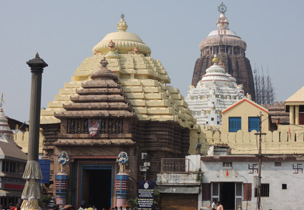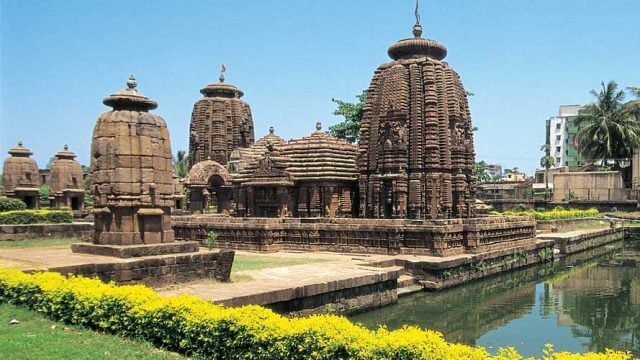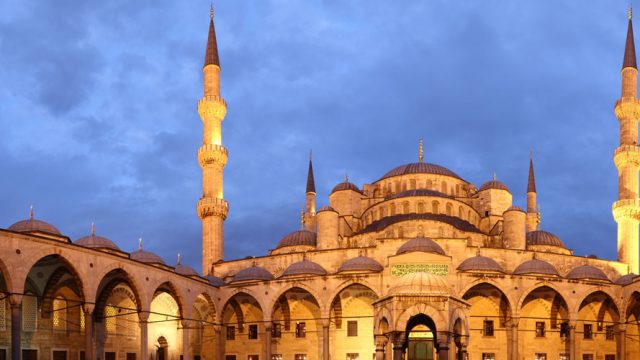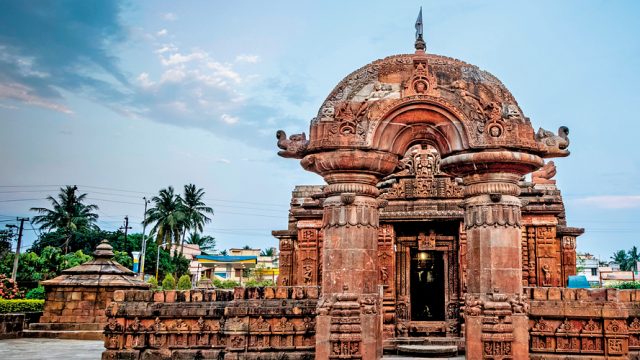Puri
Located on the Bay of Bengal coast, this seaside resort of Odisha is also the abode

Main temple
The richly carved 12th century temple houses the wooden idols of Lord Jagannath (an incarnation of Vishnu) and his siblings, elder brother Balabhadra and younger sister Subhadra. There are many other temples within the complex. The Brahmin priests (locally called panda) seem to run the show. If you want to avail their services, fix the remuneration first. You will be asked for donations at almost every step; it is not compulsory and best ignored unless you want to donate. http://jagannath.nic.in/.
Only Hindus are allowed to enter the temple complex. Cellphones, cameras, leather items and heavy bags are not allowed inside; you will have to deposit them at the counters outside for a token fee.

The idols
There are many legends explaining the cult of Jagannath and the genesis of the idols. The deities have no limbs as the divine sculptor had vanished leaving the wooden idols incomplete because the king had failed to keep his promise. Besides the daily rites and rituals, the temple has a long list of festivals, including dressing up the idols in various attire throughout the year. The idols remain on the pedestal round the year, except during the annual snanyatra and rathayatra festivals.

Ananda Bazar
Puri is one of the four ‘dham’ associated with Lord Vishnu. It is said that Vishnu bathes at Rameswaram, meditates at Badrinath, dines at Puri and sleeps at Dwarka. Hence, the ritual food offering (bhog or mahaprasad) in Puri is of great significance. Not only does Jagannath partake of a variety of food at different hours but the kitchen, known as Ananda Bazar, is said to be the largest kitchen in the world.

Snanyatra and Anasara
The snanyatra or the bathing ritual is held on the full moon day of the month of Jyestha. The idols are taken to a special platform and bathed with 108 pitchers of water. Then Balabhadra and Jagananth are dressed to look like the elephant-headed god, Ganesha. But all that bathing makes them ill and the three idols retire sick. They remain in seclusion for a fortnight (anasara), only to reappear during the Rathayatra festival which is held at the end of the fortnight.
Rathayatra
Every year (except the year of the Nabakalebara festival), on the second day of the bright fortnight of the month of Asad (June-July), the three idols are taken out of the temple and seated in their individual towering chariots (Ratha) for the drive to their aunt’s house, the Gundicha Temple. The chariots are pulled by the pilgrims, numbering a few lakhs. You can either join the crowd who throng the road in front of the temple or if you want to avoid the crowd, buy a ticket to the seating galleries set up by the wayside to see the Rathayatra.
Daitapati
They are a special class of priests who carry out the entire exercise of the Rathayatra festival. They are said to be the descendants of the king of the Shabar tribe who owned the idol of Neelmadhav. Neelmadhav later began to be worshipped as Jagannath.

The chariots
The idols have their own chariots, which are crafted every year. The day before Rathayatra, the chariots are lined up in front of the temple. Balabhadra’s chariot is called Taladhwaja – the 44-feet high chariot is draped in red and blue cloth; it has 14 wheels. Subhadra’s chariot is called Darpadalan – the 43-feet high chariot is draped in red and black cloth; it has 12 wheels. Jagananth’s chariot is known as Nandighosa – the 45-feet high chariot is draped in red and yellow; it has 16 wheels. Each wheel has a diameter of seven feet. The chariots’ decorations display Odisha’s traditional art.
Pahandi
Carrying the idols from the pedestal to the chariot in a typical fashion and to the accompaniment of music is known as pahandi. It is not easy to carry the heavy idols, especially through the crowd pressing from all sides to touch the idols.
Chhera Pahanra
One of the unique rituals of the Rathayatra festival. The king of Puri sweeps the three chariots with a golden broom to prove that everyone is same in front of god.
Bahudayatra
It marks the return of the idols to the temple after their week’ stay in the Gundicha Temple. The idols ride their chariots back to the temple but cannot enter immediately.

Sunabesh
The day after Bahudayatra, the idols, still seated in the chariots, are decorated with new clothes and fitted with hands, arms and a crown made of solid gold. More rituals follow over the next two days after which the idols are taken inside the temple and reseated on their pedestals.

Nabakalebar
Every 12 to 19 years, the existing idols are replaced by new ones; ‘nabakalebar’ means a new body. Special ceremonies are held to acquire the wood from the divinely indicated trees and the new idols are made from them. One of the most important ritual during this time is the Brahma Paribartan, when the soul from the old idol is transferred to the new one. It is held in utmost secrecy. The old idols are buried inside the temple premises. The newly painted idols will be taken out for the annual Rathayatra of that year. http://nabakalebara.gov.in/.

Excursions
Puri, Bhubaneswar and Konark form the ‘golden triangle’ of Odisha and can be seen at one go. From Puri, Bhubaneswar (noted for its old temples) is 65km away and Konark (noted for the Sun Temple) is 36km away (part of the way lying along the sea coast). Raghurajpur, about 16km from Puri, the birthplace of Odissi exponent, late Kelucharan Mahapatra, is an artist’s village where people practice many of the traditional art forms such as patachitra painting, palm leaf engraving, wooden toys, etc. Satapada, about 50km from Puri, is at one end of the Chilika Lake and an area known for dolphin watching. http://orissatourism.gov.in/.
Konark
Odisha
Puri
Leave a Reply
You must be logged in to post a comment.





